1830, U.S. Census: total population, 12.87 million; slaves, 2.01 million (15.6%); free black, 320,000 (2.5%).
In Louisiana, 51% of population is slave and 13% is free black (attributed to history under French Code Noir). In Mississippi, 48% of population is slave, and less than 1% is free black. South Carolina population is 54% slave, and it will lead in percentage slave through 1860 (when it is 57%).
Immigration in 1820s, 143,000, up more than 100 percent over 1810s, with increasing numbers from Germany and Ireland. Overall population, including immigrants, is up more than 33% for decade; enslaved population, despite continued ban on imports, is up more than 30%.
1830, Pres. Jackson signs Indian Removal Act, May 28 (which passed House by only four votes). Transfers Indian land to Southern states to sell for new white plantations. The Cherokee (northern Georgia), Muscogee/Creek (eastern Alabama), Choctaw (central-east Mississippi), Chickasaw (northern Mississippi) and Seminole (central Florida) receive compensatory land west of the Mississippi.
Besides these “Five Civilized Tribes,” Wyandot, Kickapoo, Potowatamie, Shawnee and Lenape (the latter originally from lower Hudson and Delaware river areas) are also affected.
Congressman Davy Crockett (Tennessee) says his vote against the Removal Act, “will not make me ashamed in the Day of Judgment.”
1830, South Carolina Canal and Railroad opens its first six miles of track, from Charleston west toward Hamburg. Slaves are leased to lay track through swamps where white workers won’t go.
Southern railroads develop quickly to move cotton from inland counties to Charleston, Savannah, Mobile, New Orleans and to Mississippi river ports as well. By 1840 railroads are buying thousands of slaves and leasing thousands more. Blacks will make up much of the rail work force well into the 20th century.
Note: The John Henry legend is believed to be based on a crew working in the 1870s on a Chesapeake & Ohio tunnel in West Virginia.
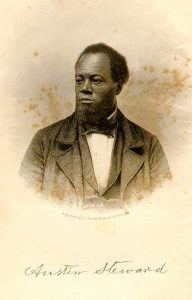 Austin Steward was a supporter.
Austin Steward was a supporter.
1830, First refugee families from 1829 Cincinnati riots reach what will become the Wilberforce Colony near London, ON. Stephen Duncan, the Mississippi cotton king, and James Brown, a former slave master and U.S. senator from Louisiana, purchase and donate 400-acre tract, Sept. 30. Quakers of Oberlin, OH, also help.
Named for the champion of abolition in Britain’s Parliament, the community establishes schools, various mills and draws many more black Americans from Northern cities
Black abolitionist Austin Steward of Rochester, NY, helped many fugitives reach the colony.
Eventually grows to as many as 200 families, but conflicts lead to decline of black population over following 20 years.
1830, Brazil decrees that all captives entering country will tbe considered free, fulfilling treaty with British.
While the law is not strictly enforced, the numbers of slaves brought in initially decline. Current slaves are not freed.
1830s, Apache and, especially, the Comanche raid Texas and Mexico from the vast Comanchería (West Texas and eastern New Mexico). After Comanche reach truce with Texas in 1844, Mexicans south of the Rio Grande are particularly hard-pressed to fend off increasing raids.
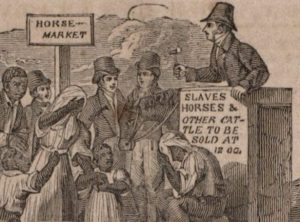 Auction pictured in Liberator.
Auction pictured in Liberator.
1831, William Lloyd Garrison launches The Liberator in Boston, Jan. 1, to lead fight for immediate, uncompensated freedom of slaves through moral and spiritual revolution, not through political movements or war. Noted for his unrelenting attacks on Southern churches for supporting slavery.
Garrison credits John Rankin’s Letters on Slavery (1826) as “the cause of my entering the anti-slavery conflict.” Rankin is a Presbyterian minister in Ohio, active in the Underground Railroad.
1831, Reaffirming earlier judgments, Ohio Supreme Court rules that mixed-race persons who are more white than black are entitled to rights enjoyed by whites. Thus Ohio departs from the “single-drop” rule prevailing in the slave-holding South.
In practice, it is left to local officials to determine if a man is sufficiently white to vote under these conditions; the issue will be frequently litigated through to the Civil War.
1831, Stephen Duncan, nation’s leading cotton slave master, forms the Mississippi Colonization Society with other major planters (including Isaac Ross and Edward McGehee), June. They support a policy of gradual emancipation and quick emigration to Mississippi-in-Africa, purchased near Liberia.
Ross’s will frees 300 slaves on his death in 1836, and orders sale of land to pay for their transport to Mississippi-in-Africa.
The Mississippi group joins forces with the American Colonization Society, and Liberia annexes Mississippi-in-Africa in 1847.
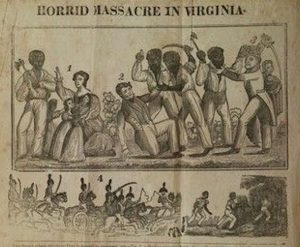 Whites shocked by killings.
Whites shocked by killings.
1831, Nat Turner, slave preacher, leads four-day rebellion in Southampton County, VA, Aug. 21-24. He and followers, slave and free, travel from house to house, freeing slaves, and killing white men and several women (about 60 persons). Militia and fearful mobs kill many blacks (perhaps most of whom are innocent) while hunting participants; Turner found six weeks later with Nottoway Indians.
Turner and 55 others tried and hanged; Turner’s body drawn and quartered. A number of blacks acquitted.
The following year, gradual emancipation is proposed in Virginia General Assembly by Thomas Jefferson Randolph, grandson of the former president. It is debated and defeated, 73-58.
Legislature instead passes laws forbidding teaching slaves to read and write, and forbidding religious meetings of blacks without a white minister.
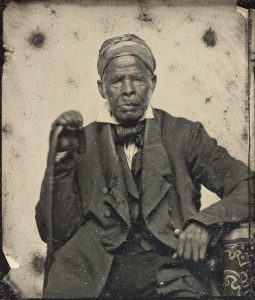 Omar ibn Said.
Omar ibn Said.
1831, Omar ibn Said, enslaved in North Carolina, writes his autobiography in the Arabic he learned growing up in Futa Toro region of Senegal.
He reports he was born in 1770 to a wealthy family, and became a merchant and Koranic teacher. He was captured by a neighboring people seeking to depose Abdul Kader Kane, the Futa Toro leader, and transported to Charleston in late 1807. He ran away only to be captured in North Carolina.
1831, Baptist War slave revolt, led by Sam Sharpe, an enslaved deacon, breaks out Dec. 27 on Jamaica, involving perhaps 60,000 of island’s 300,000 slaves. Launched as a largely non-violent work strike (after hopes of an emancipation announcement from England are dashed). Then manor houses and sugar works are set afire. Still, only 14 whites killed.
Maroons brought in by British military are key to suppression of insurrection, Dec. 31. At least 207 slaves die during revolt; another 300-plus executed later.
Britain reacts: The brutal suppression of this third major revolt in British West Indies in 15 years accelerates drive in Britain to emancipate slaves in the colonies. The others were on Barbados, 1816, and Demerara, 1823.
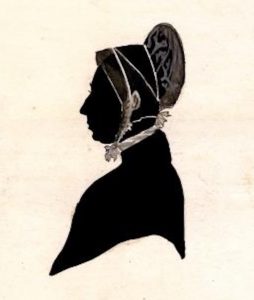 Elizabeth Heyrick in silhouette.
Elizabeth Heyrick in silhouette.
1831, Younger members of Anti-Slavery Society in Britain devote themselves to “immediate, not gradual abolition,” first championed here by pamphleteer Elizabeth Heyrick of the Female Society of Birmingham.
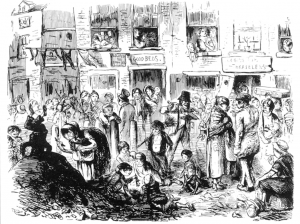 Disease sweeps through cities.
Disease sweeps through cities.
1831, World’s second cholera pandemic (believed to have originated in India in 1829) reaches London in September, then crosses Atlantic in June via immigrant ships to Montreal (where 1,900 die), New York (3,500) and, in 1832, Philadelphia (whose low death rate is attributed to clean reservoir water).
Mass deaths of newly arrived slaves are reported in 1833 in Havana and Matanzas.
 Black Hawk.
Black Hawk.
1832, All but 200 of the “British Band” of 1,500 Fox and Sauk die at hands of U.S. troops and Dakota warriors at Battle of Bad Axe River (WI), ending year-long Black Hawk War, Aug. 2. Conflict began when Black Hawk led band across Mississippi to plant corn on Illinois tribal land. Jefferson Davis and Abraham Lincoln serve as officers; only Davis sees action.
Black Hawk and five lieutenants are held for a few weeks at Fort Monroe, VA. They meet with Pres. Jackson, attend dinners and plays, and find themselves accepted as celebrities.
But their defeat leads to removal of most Indians from Old Northwest to lands west of Mississippi.
1832, Thomas R. Dew of William & Mary publishes Professor Dew on Slavery, describing economic and moral necessity of slavery. His writings play a role in turning the Virginia legislature away from gradual emancipation and toward eventual support of secession and, eventually, opposition to Reconstruction.
He focuses on Virginia’s economic dependence on slavery and makes few claims of Christianity’s supposed acceptance.
 New York: First performance.
New York: First performance.
1832, “Jump Jim Crow,” a song ridiculing black people performed in blackface at the Bowery Theatre in New York by its white originator, Thomas D. Rice. Following the Civil War, Southern states pass repressive Black Codes, which come to be known as “Jim Crow” laws.
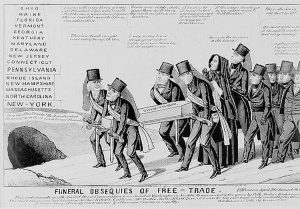 'Burying' Free Trade.
'Burying' Free Trade.
1832, South Carolina declares federal tariff laws “null, void and no law” in the state, based on John Calhoun’s nullification doctrine, Nov. 24 (thus raising question of whether a future federal anti-slavery law could by nullified by a state).
Pres. Jackson asserts that federal law is supreme and warns that “disunion by armed force is treason,” Dec. 10. South Carolina fails to win support from other states.
1832, New Whig majority in House of Commons, led by Earl (Charles) Grey, passes major reform of Britain’s electoral system, abolishing “rotten boroughs” (which provided wealthy pro-slavery forces votes), bringing cities and countryside into better balance and nearly doubling the electorate (still male only). Lords reluctantly agree after Grey and King William IV threaten to expand peerage. Royal assent received June 7.
Leads to yet another election in which Whigs capture two-thirds of Commons, paving the way for Abolition of Slavery Act.
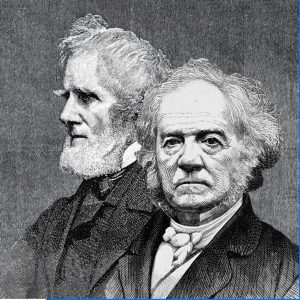 Arthur and Lewis Tappan.
Arthur and Lewis Tappan.
1833, American Anti-Slavery Society formed in Philadelphia to preach case for immediate, uncompensated emancipation, December. Lead founders are William Lloyd Garrison and Arthur Tappan; a third of the delegates are Quakers.
Also important are Lewis Tappan, Theodore D. Weld, Theodore S. Wright (a black minister from New York), Susan B. Anthony, Lucretia Mott and Beriah Green Jr.
1833, Young William Gladstone lobbies Britain’s Whig government on behalf of West Indies plantation owners for compensation if slaves are to be emancipated.
Outcome: a £20 million fund, judged to be about half the total value of all slaves in British colonies (and 40% of total government expenditure in 1834).
Also proposed is that adult ex-slaves continue as apprentices for 12 years, but that period is much reduced in final legislation.
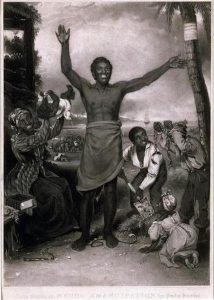 Celebrating on Jamaica.
Celebrating on Jamaica.
1833, Abolition of Slavery Act is passed by a progressive Whig Parliament, ending slavery in all British territories, pushed by Henry Peter Brougham, the lord chancellor, and Earl Grey, the prime minister.
Greatest impact is on Britain’s Caribbean holdings, with Jamaica alone accounting for more than a third of the 800,000-plus enslaved population. Following their emancipation, a six-year period of apprenticeship is permitted for former slaves (later reduced to four years). Slave masters receive compensation. To take effect Aug. 1 1834.
Wilberforce, who began the long abolitionist campaign in Parliament, dies July 29, seven days after it passes the Commons.
Sir John Gladstone receives the largest single compensation, more than £90,000.
1833, Richard Robert Madden named a magistrate to oversee liberation of Jamaica’s slaves. He goes on to defend free blacks in Cuba (which is evading treaty on slave-trade ban), to testify in the Armistad case and to unmask British merchants illegally supporting slave trade out of West Africa factories, 1840. He writes extensively on slavery and on the United Irishmen.
Madden’s wife, Harriet, is a daughter of a leading Jamaican slave master.
1833, A young Quaker editor and poet, John Greenleaf Whittier, publishes Justice and Expediency to promote the cause of abolition. He works closely with William Lloyd Garrison, Gamaliel Bailey, Charles Sumner and many others. A collection of abolition poetry, Voices of Freedom, is published in 1846.
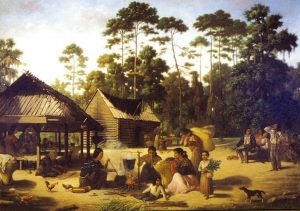 Choctaw village before removal.
Choctaw village before removal.
1833-1835, Federal government sells more than 4 million acres of land in Mississippi, most of it formerly held by the Choctaw and Chickasaw removed by end of 1832. New plantation owners purchase thousands of slaves in Virginia and Tennessee.
By 1836, Mississippi alone is producing 125 million pounds of cotton (up 47% over 1834) and nearly 200 million pounds by 1839, almost a quarter of U.S. total.
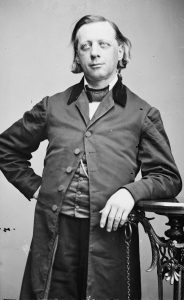 Henry Ward Beecher.
Henry Ward Beecher.
1834, Students who will go on to lead abolitionists hear anti-slavery speakers gathered at the new Lane Theological Seminary (Presbyterian) outside Cincinnati, February. Virtually all support abolition over colonization.
Participants include Theodore Weld; Lyman Beecher, Lane’s president, and his son and daughter, Henry Ward Beecher and Harriet Elizabeth Beecher; and disenchanted former members of the American Colonization Society. Also, former slave James Bradley, the only black to speak, and John Rankin, already an Underground Railroad leader. Note: Arthur and Lewis Tappan are financial supporters of Lane.
Results: Students move to create schools for black people in Cincinnati, while pro-slavery whites threaten violence. When fearful Lane trustees disavow slavery discussions, rebel students turn to just-opening Oberlin Collegiate Institute, near Cleveland, which agrees not only to unlimited discourse, but to enrollment of African-American students. Oberlin soon becomes a “hot-bed of Abolitionism.”
Oberlin becomes the nation’s first coeducational college in 1844 when it admits four women.
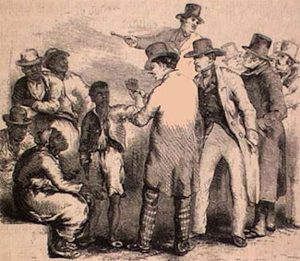 Damage, but no deaths.
Damage, but no deaths.
1834, In New York, anti-abolitionist riots break out July 9, with rising Irish immigrants a factor. Incendiary reports in Courier and Enquirer (which supports American Colonization Society) claim abolitionists like Arthur and Lewis Tappan encourage daughters to marry black men.
Considerable damage to Bowery Theater, homes of abolitionists, ransacked black neighborhoods and at least seven churches before New York 1st Division patrols streets.
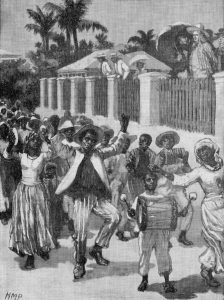 Barbados, Aug. 1.
Barbados, Aug. 1.
1834, Emancipation Day arrives throughout the British Empire as the Abolition of Slavery Act takes effect, Aug. 1. But the newly free people are still obligated to work as indentured servants for six years.
This is reduced to four years, and final freedom arrives in 1838.
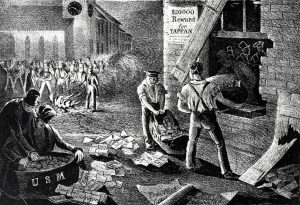 Charleston: Pamphlets burned.
Charleston: Pamphlets burned.
1835, American Anti-Slavery Society declares postal war by printing, in New York, more than a million pamphlets illustrating horrors of slavery, and mailing them throughout nation, including to countless Southerners who are infuriated, August. The Tappan brothers are main movers of the campaign.
Southerners respond with mailbag bonfires, and searches of ships and stages. Pres. Jackson finally approves embargo on such materials by New York postmaster.
1835, Dr. Reuben Crandall is arrested in Georgetown, Aug. 10, and charged with distributing Anti-Slavery Society pamphlets with the intent of inciting a revolt among slaves in the District of Columbia. The prosecuting U.S. attorney is Francis Scott Key (author of the 1814 lyrics to “The Star-Spangled Banner”).
The arrest helps feed a riot by white mechanics striking at the Navy Yard who surround the City Hall jail until the militia is called, and then ransack a restaurant owned by Beverly Snow, a free black man. Black churches, businesses and homes are vandalized through the week.
At his trial the following April, Crandall asserts he is no abolitionist (although his sister, Prudence, is well known for schooling black girls). Witnesses say the incendiary pamphlets were used only as packing material for Crandall’s medical gear. The jury acquits Crandall after deliberating three hours. Crandall eventually moves to Kingston, Jamaica, hoping for relief from tuberculosis contracted during his eight months in jail. He dies there in 1838.
Key, a slave owner and leader of the American Colonization Society, has, over the years, represented both slave owners and slaves seeking freedom. His political ambitions are much diminished after the trial.
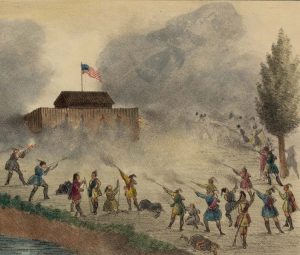 Seminole attack forts.
Seminole attack forts.
1835, Although northern Seminole migrate to Indian Territory in 1834, Seminole in central Florida oppose U.S. attempt to force their removal after treaty creating a large reservation collapses.
Second Seminole War opens with Indians and blacks ambushing a 110-man U.S. army contingent near Fort King (present-day Ocala), killing Maj. Francis Dade and all but two of his men, Dec. 28.
In 1836, Seminole and allied blacks attack isolated forts and 21 plantations despite large U.S. forces, and burn the Cape Florida lighthouse. Seminole force of 600, led by Osceola, holds off 2,500 militia and Creek at Wahoo Swamp, December.
Osceola is seized at a duplicitous truce conference, 1837, and dies in Fort Moultrie prison, SC. A battle on north shore of Lake Okeechobee is deemed a tie (Christmas Day, 1837).
1835, “Amazing Grace” is set to tune of “New Britain” by Baptist song leader William Wyler of Spartanburg, SC, in his book, Southern Harmony.
Latter music was long favored (with other lyrics) at camp meetings and other Second Great Awakening events.
1835, Britain and Spain tighten enforcement of slave-trade agreement. British warships authorized to stop Spanish slavers and bring them before “Mixed Commissions” in Sierra Leone and Havana.
Vessels carrying extra mess gear, foodstuffs, water tanks and lumber to build slave holds are declared to be slavers under “equipment clause,” even if no captives are present.
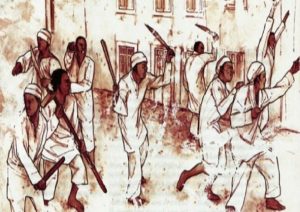 Malê rebellion in Salvador.
Malê rebellion in Salvador.
1835, Several hundred Malês, African-born Muslims, rise up in Salvador, Brazil, during Ramadan. They are blocked from joining plantation slaves outside the city and finally cut down by cavalry.
Leaders include a Nupe slave, two Nagô (Yoruba) slaves, a Nagô freedman and a Hausa freedman. Leaders who survive the fighting are executed, 16 others are imprisoned and 45 flogged.
An additional 200 slaves and freedmen are deported to the Portuguese post at Porto-Novo, Benin, where they found a Muslim Afro-Brazilian community that ultimately builds a grand mosque.
The Malê Revolt, although suppressed, is considered a vital step toward emancipation in Brazil.
1836, Arkansas joins Union as 13th slave state compared to 12 free.
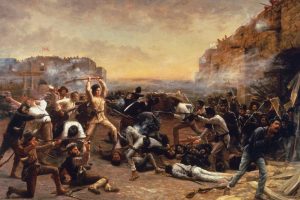 'Remember the Alamo!'
'Remember the Alamo!'
1836, Texas declares itself a republic, independent of Mexico. Major factor: Texans want to continue slavery, which Mexico has abolished.
Alamo defenders die, San Antonio, March; Mexican army under Santa Anna routed by Sam Houston's forces at San Jacinto, April.
Conflict flares and subsides until Texas is annexed as a state in 1845, leading to war with U.S.
1836, Congress’s new “gag rule” tables all petitions re slavery without debate.
1836, Massachusetts Chief Justice Lemuel Shaw rules that six-year-old Med, a slave girl brought to Boston by a New Orleans woman, is automatically free upon entering Massachusetts, a free state. Cites Britain’s “Somerset” principle.
This becomes the guiding precedent in many Northern states. But Shaw makes clear this does not apply to fugitive slaves, because the U.S. Constitution requires they be held for their masters.
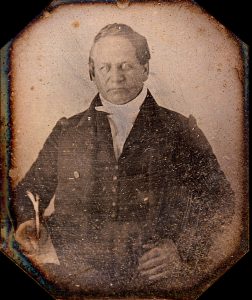 Alexander Twilight.
Alexander Twilight.
1836, Alexander Twilight is first African-American elected as a state legislator, in Vermont, and the only one before the Civil War.
The son of mixed-race parents, he is also first African-American to graduate from college (with a BA from Middlebury), going on to become a school principal and minister.
1836, Old Hausa state of Gobir rebels against Sokoto Caliphate, with Taureg and Maradi as allies. Gobir’s Sultan Ali leads massacre of residents of Karatu.
Sokoto is now one of Africa’s largest states with 30 internally independent emirates and a total population of perhaps 10 million, a quarter of them slaves, but with specific rights, including right to freedom if they convert to Islam.
Emirs are not hereditary, but appointed by sultan. A council of emirs selects new sultans, with Islamic scholarship highly valued.
Current Sultan Bello strikes back at Battle of Gawakuke, overwhelming rebels, who are said to suffer more than 20,000 killed, including Sultan Ali.
Bello’s army rampages through Gobir to avenge Karatu. A new ribat fort and plantation is established to enforce peace.
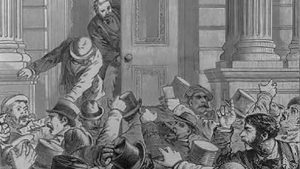 Many banks go under.
Many banks go under.
1837, Collapsing cotton prices (cotton production has nearly doubled since 1830) play a large role in nationwide Panic of 1837.
Over-leveraged plantation owners (especially in newly booming Mississippi) can’t meet payments on massive loans from London and New York banks. Banks cut back on all other lending; bank runs force more than 340 to close.
Low cotton prices hurt federal, state revenues as well. Prices for slaves, which banks accept as collateral, also drop, from recent highs near $2,000, to as little as $1,000.
Wheat crops are depressed by hard winter and a Hessian fly infestation, pushing the price of flour up; in New York it doubles to $12 a barrel, which sets off a 5,000-person riot.
Working people squeezed by prices and sudden loss of jobs. Hard times continue, especially in Lower South, through 1842.
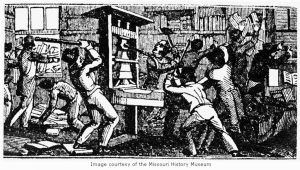 Deadly mob destroys press.
Deadly mob destroys press.
1837, Elijah Lovejoy, a Presbyterian minister and editor of fiercely abolitionist St. Louis Observer, is shot and killed Nov. 7 as a pro-slavery mob besieges a warehouse in Alton, IL, where he had hidden a new printing press.
Lovejoy becomes a martyr to the abolition cause, cited by Lincoln and by John Brown when the latter declared in his own church weeks later, “Here, before God, ... from this time, I consecrate my life to the destruction of slavery.”
1837, Michigan joins Union as 13th free state, compared to 13 slave. Balance doesn’t change until Florida and Texas enter as slave states in 1845.
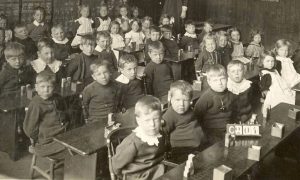 Free schools are pioneered.
Free schools are pioneered.
1837, Horace Mann named secretary of the new Massachusetts Board of Education, nation's first.
He pushes for free schools for all classes (white), for professional trained teachers (women preferred), for statewide curriculums and for reliable school financing through local property taxes.
A few months earlier, William Holmes McGuffey, a former teacher, brings out the first two Eclectic Readers, which become famous as McGuffey’s Readers. They quickly replace Webster’s Blue-Backed Primer as the most widely used U.S. schoolbooks. Eventually six Readers, more complex by grade, take children from phonics and letters, to reading sentences, to simple stories, to essays, poems and speeches by well-known writers.
1837, Presbyterians split, with New School comprising pro-revivalist, reform-minded, mainly Northern members, led by Lyman Beecher (father of Henry Ward Beecher and Harriet Beecher Stowe) among others.
Conservative Old School includes most of the largely Scots-Irish Presbyterians in the South, but retains Northern adherents as well.
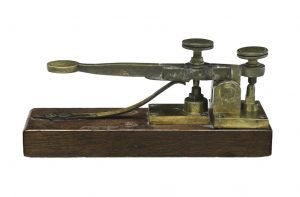
Samuel Morse's telegraph.
1837, Samuel Morse receives patent for his improvements on telegraph and for the Morse Code.
John Deere invents one-piece steel plow.
1837, Smallpox epidemic sweeps through many Plains Indian tribes. In just one group, the Blackfeet, 6,000 die.
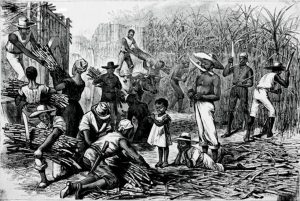 Slaves cut Cuban cane.
Slaves cut Cuban cane.
1837, First rail line opens on Cuba. Connecting sprawling slave-plantations to expanded, steam-powered sugar mills, trains help boost sugar production to new heights.
By 1840s, after low coffee prices force planters to switch more land to sugar, Cuba is world’s leading sugar producer. By 1885, it is producing nearly 1 million tons a year, 14% of world’s total.
Free trade with U.S. (permitted by Spain since 1818) provides a huge market.
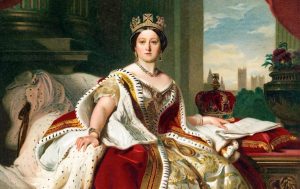 Britain's new queen.
Britain's new queen.
1837, A month after turning 18, Alexandrina Victoria becomes queen at the death of William IV, her uncle, June 20.
Victoria’s support of the anti-slavery cause is made known through her husband, Albert, after their wedding in 1839.
1837, Britain invites U.S. and France to create a joint international patrol to stop slaving. Administration of Pres. Van Buren declines to participate.
1837, Small, personal altercations lead Ahanta King Badu Bonsu II to rebel against Dutch on Gold Coast. He ambushes an expeditionary force seeking to arrest him, killing 45 including Hendrikus Jacobus Tonneboeijer, the 23-year-old acting Elmina governor, Oct. 23.
More than 200 troops are sent from Amsterdam the following spring. They find allies in rivals to Ahanta, who then give up Bonsu. He is hanged; 13 others are exiled to Nusa Kambangan prison island in the East Indies, and another 36 are forced to work Elmina plantations. Dutch reorganize protectorate to maintain closer control.
In 2005, the severed head of Bonsu is discovered in a jar of formaldehyde at Leiden University Medical Center; it is returned to Ghana for ceremonial burial.
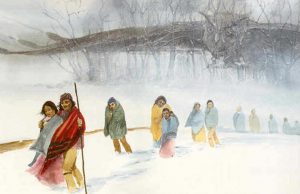 Cherokee leave Georgia.
Cherokee leave Georgia.
1838, The forced, final removal of the Cherokee nation from northern Georgia to new Indian Territory—“the Trail of Tears”—is ordered by Pres. Martin van Buren (New York). Of more than 15,000 people following three routes, more than 4,000 Cherokee and 2,000 of their slaves die of winter exposure, lack of food, disease.
Survivors settle on new reservations east of Tulsa, OK, founded by Muscogee/Creek Indians who arrived two years earlier.
Also previously, army and state militia enforce expulsion of Choctaw and Chickasaw tribes from Alabama and Mississippi to the Indian Territory, and continue campaigns against Seminole in Florida.
1838, Daniel Pratt opens a cotton-gin factory on Autagua Creek near Montgomery, AL, which becomes the largest manufacturer of gins in the world, producing 1,500 gins annually. After the Civil War he invests in Alabama’s North and South Railroad, and in the new iron and steel city of Birmingham.
1838, Frederick Douglass, age 20, escapes slavery in Baltimore via train to New York, aided by Anna Murray, a free black woman, and by papers from a free black sailor.
He marries Anna in New York; they settle in New Bedford, MA, to begin a family. He becomes active in AME Zion church, where he is discovered by William Lloyd Garrison.
1838, Most colonial assemblies in British West Indies introduce legislation dismantling apprenticeship system for former slaves (all freed by Parliament as of 1834). Laws against vagrancy and squatting attempt to enforce plantation economies, with varying results.
Tale of two British West Indies: At full emancipation on Aug. !, Trinidad has 17,439 former slaves, with most slave owners having held 10 or fewer. Jamaica, twice as large as Trinidad, has 360,000 former slaves (or 20 times more).
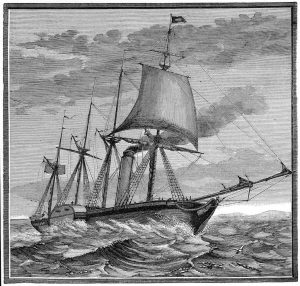 Just 14 days to New York.
Just 14 days to New York.
1838, Isambard Brunel’s Great Western, first steamship built for regular trans-Atlantic crossings, departs Bristol for 14-day crossing to New York (half the time required for wind-driven packet ships). She is followed by the British Queen, 1839, and the Britannia, 1840. All are sidewheelers.
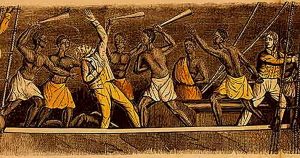 Slaves take over La Amistad.
Slaves take over La Amistad.
1839, Slaves (Mende people)--obtained from a slave-trade base at Lomboko, Sierra Leone, by Portuguese ship Tercora-- are secretly transferred at Havana to Spanish coaster La Amistad. Slaves, led by Cinque, rise up, kill captain and several crew, and try to force owners to return them to Africa. But ship is stopped by U.S. Coast Guard brig off Montauk Point, Aug. 26.
Courts rule in favor of slaves with final decision to free them issued by U.S. Supreme Court, March 1841. Lewis Tappan persuades John Quincy Adams to argue for the defense; Capt. Peter Fitzgerald of Royal Navy testifies to horrors of slave ships. Justice Joseph Story writes the opinion with only one dissent.
1839, American Slavery as It Is: Testimony of a Thousand Witnesses is published by the Anti-Slavery Society.
Authors are Theodore Weld, and Angelina and Sarah Grimké (Weld’s wife and sister-in-law). The Grimkés are the only Southern-born women (they grew up in Charleston) to become abolition leaders.
Most of the 1,500-plus state and local abolitionist societies now active in the free states are associated with the Anti-Slavery Society.
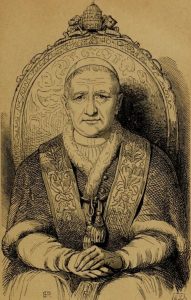 Pope Gregory XVI.
Pope Gregory XVI.
1839, Pope Gregory XVI issues In supremo apostolatus, a papal bull that clearly denounces the slave trade and less clearly calls for an end to slavery itself, Dec. 3. It does not specifically call for emancipation.
John England, Charleston’s first Catholic bishop, interprets the bull as a condemnation of large-scale slave trading but not of ongoing ownership of slaves by individuals. He writes 18 letters to Secretary of State John Forsyth, asserting that this is the view of most American bishops.
1839, HMS Buzzard captures two slavers, Eagle and Clara off Lagos (present-day Nigeria). Because they fly American colors, they are escorted to New York with slave cargoes, June 12. Court rules they are actually owned by Spain. Royal Navy brings in two more slave ships flying the U.S. flag. They are condemned.
Nicholas Trist, U.S. consul in Havana, recommends dispatch of a naval squadron to West Africa to patrol for slavers, warning that the British will continue to police American vessels if U.S. does not act.
